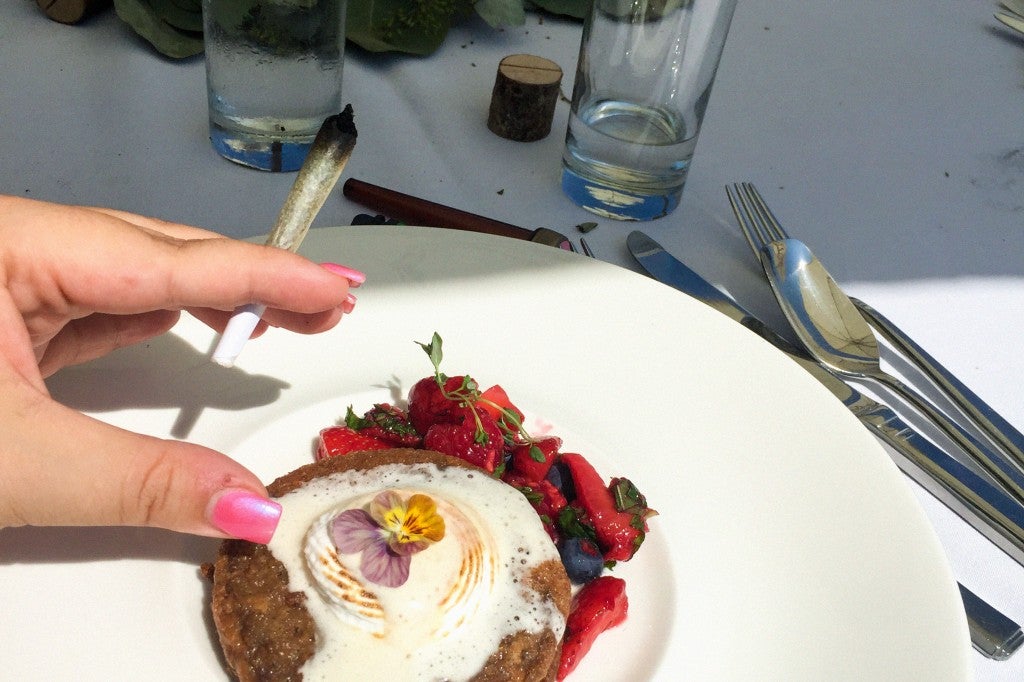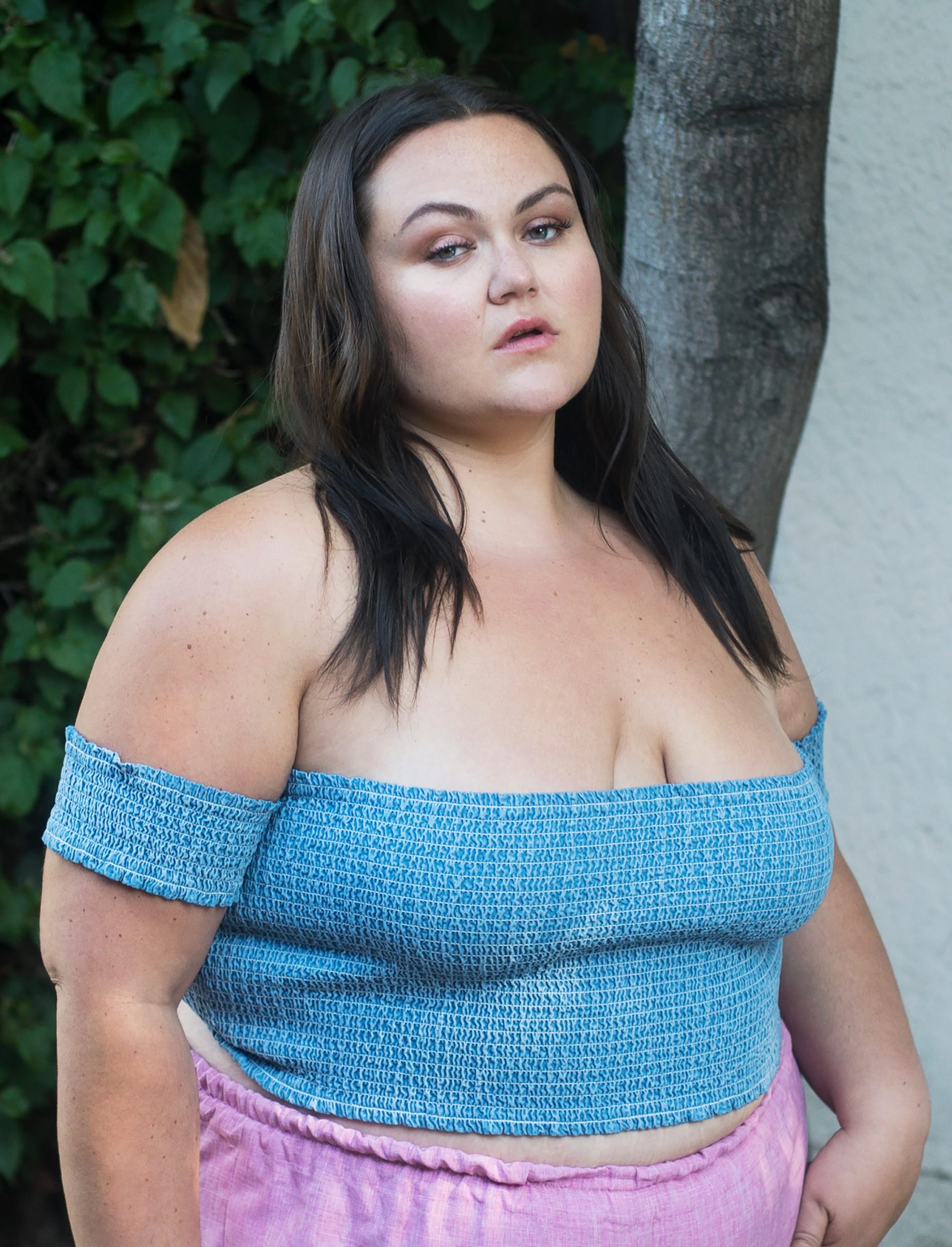I thought we were going to Malibu.
Instead, I’m boarding a shuttle at the Hilton in Westlake Village, the Republican enclave in Ventura County known for, well, nothing. I’m headed to the Emerald Exchange, the two-day farmers market and festival where weed is celebrated as “plant medicine” and brands showcase their product in hopes of building out their marketing and distribution opportunities.
My confusion is warranted. The event was initially marketed as “From Mendo to Malibu” since it brings Northern Californian growers down to network with cannabis entrepreneurs and to sell to connoisseurs in the lower-half of the state. (“Mendo” refers to the 420-fertile Mendocino Valley, a couple hundred miles north of San Francisco and one of the first areas to mass produce marijuana.)
But the Malibu portion of the experience feels as far away as Mendo as we sit in mid-day traffic. “Where are they taking us?” I wonder aloud. The lady sitting next to me doesn’t answer. She just keeps strumming her ukulele, something she began long before we boarded. In fact, she had insisted on sitting next to me, up front, so that her and her uke had the proper room to groove, banishing my friend Niko to the back of the bus in order to make this happen.
Twenty or 30 minutes later, the bus zigzags through huge fruit, vegetable and palm farms until we reach a big, guarded plot of land. As we enter the lot, I notice the security guy’s bulletproof vest but can’t make out a weapon of his own. “A vest without a gun? That’s just asking for trouble,” I overhear a loud bro tell his yogi girlfriend. Suddenly, I remember the underlying illicitness of the event. It’s unlikely the federal government would invest any time or money into an Emerald Exchange crackdown, but imagining those raised stakes gives all of us a jolt.
I’m set to begin my afternoon by attending brunch at Herb, the Emerald Exchange’s pop-up restaurant by “herbal chef” Chris Sayegh. Requiring a special ticket, the brunch is advertised as an opportunity to taste Sayegh’s food before he opens L.A.’s first brick-and-mortar medicated restaurant, which also will be called Herb. Funny enough, guests are invited to choose between a cannabis-infused meal or the standard sober fare. (My fully medicated table opts for the former rather than the latter.) In the meantime, we’re brought mimosas infused with terpenes, the molecules that give weed its smell and taste.
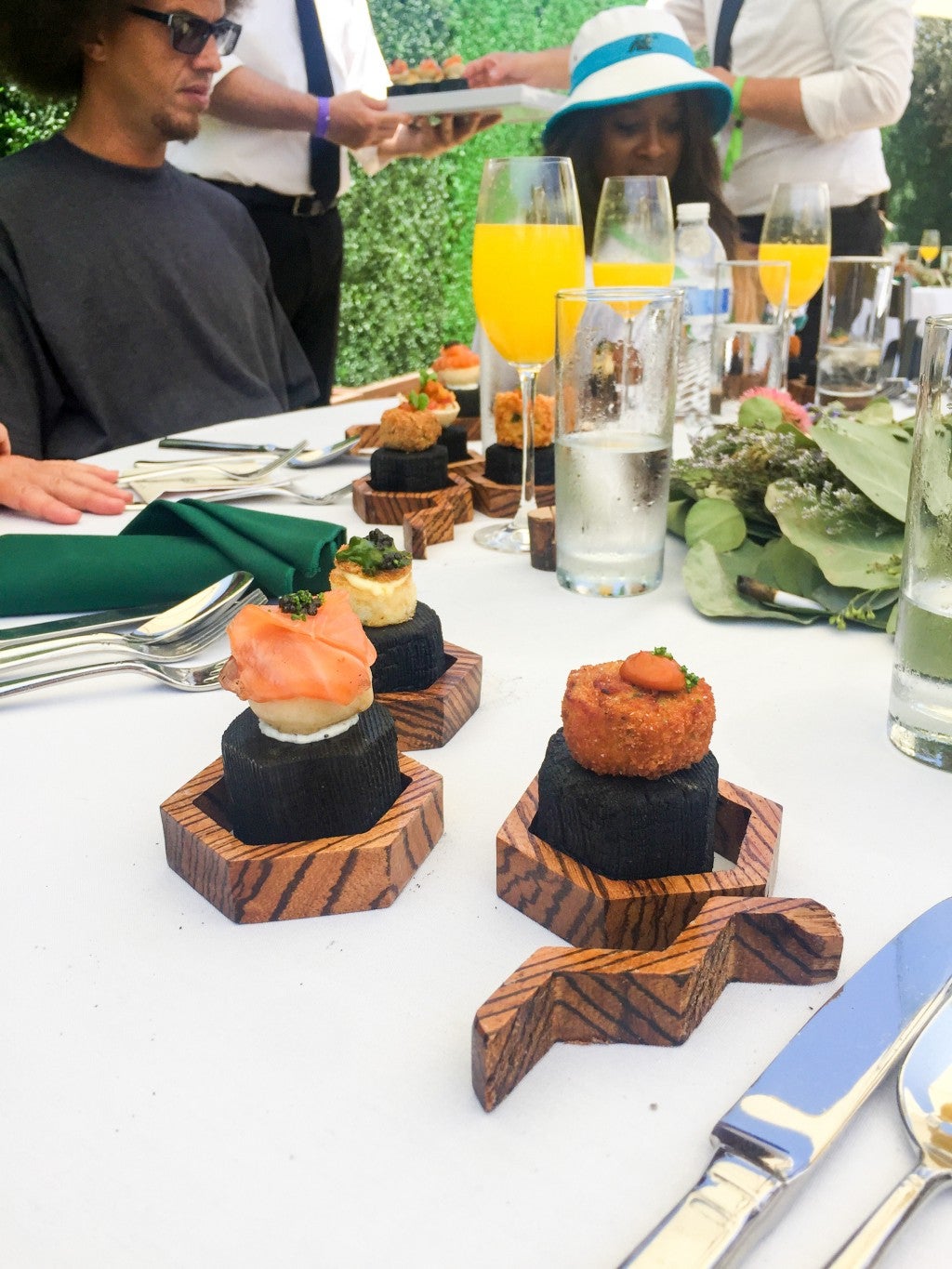
“Does the champagne have added sulfites? If so, I’ll just take juice, as long as it’s organic,” asks my new friend Julie, who looks like a Lily Tomlin-Janis Joplin hybrid and acts like one, too. She unloads two huge bags of “flower” (the insider’s word for nugs of weed), pre-rolls (joints made in advance) and edibles (everything from Matcha mints and coconut oil to sheep’s milk ice-cream and boysenberry pie) on the table. She oozes the effervescent cool of an archetype my friends and I refer to as “Old Stoner,” the sort of chill that’s cultivated only by smoking tons of weed with lots of strangers in a great deal of places for many years.
My hunch is more than right.
Julie, 58, started smoking weed in New York City when she was 13. Upon moving to California a little over a decade ago, she decided she might as well “come out” as a weed user, which wasn’t all that rebellious given that she lives in Topanga Canyon, where words like muesli and cannabinoids have been circulating for decades. Julie tells me none of her friends could afford an event like this, where general admission went for $175 and premium packages were priced between $250 and $350, so she showed up solo before offering me a token of our new friendship — two sativa joints. When Niko notices the nugs of weed embedded throughout the fairytale-esque tablescape, filled with fresh flowers and herbs besides “flower” and “herb,” the other guy at our table breaks out his pipe and we all begin to smoke that too.
Finally stoned, my lips can’t stop smiling. This is the first fine-dining experience I’ve had where all of us get ash on the table before a single plate of food is brought out. Our table is diverse in terms of age and race, but the other groups are mostly full of white bros and their Vape-smoking girlfriends, getting high together and waiting for their food. I can’t help but think of all the times stoners throughout history have shamefully turned to their friends and asked, “Dude, do I seem high?” before venturing into a social gathering. There is obviously none of this apprehension at the Emerald Exchange, where cultivating wellness, entrepreneurship and community is prioritized over just getting high.
Sayegh addresses this in his welcoming remarks, telling us that a brunch like this is a “way to destigmatize,” with all the earnest passion of a tech CEO who thinks he’s changing the world one app at a time. And while I’m happy to destigmatize weed as a proud stoner, I find the language of “progress” that inundates the event pretty funny. In fairness, though, it’s not just the weed industry. Every marketing campaign lately seems to be all about “expanding,” “awakening” and “shifting,” making it clear that in 2017, nothing sells better than the promise of revolution.
“I just came here for the novelty of it,” Julie explains. “I usually go to much cheaper seshes, $10 or so and no med card needed, even though nowadays they’re filled with that EDM.”
When I ask her how long she’s considered herself a cannabis activist, she tells me only recently did she own up to that title. As a longtime peace activist, concentrating on issues like ending U.S. military occupation and the prison industrial complex, Julie always thought that those activists dedicated solely to weed were sort of petty. But these days, she says she can’t afford not to support all of the groups that advocate for justice, including weed growers and their lobby against Big Pharma.
Mostly, though, Julie is just fun. When my beef tartare arrives and I stick my pink, acrylic nails into it, she giggles with delight. “You know how to have a good time,” she laughs.
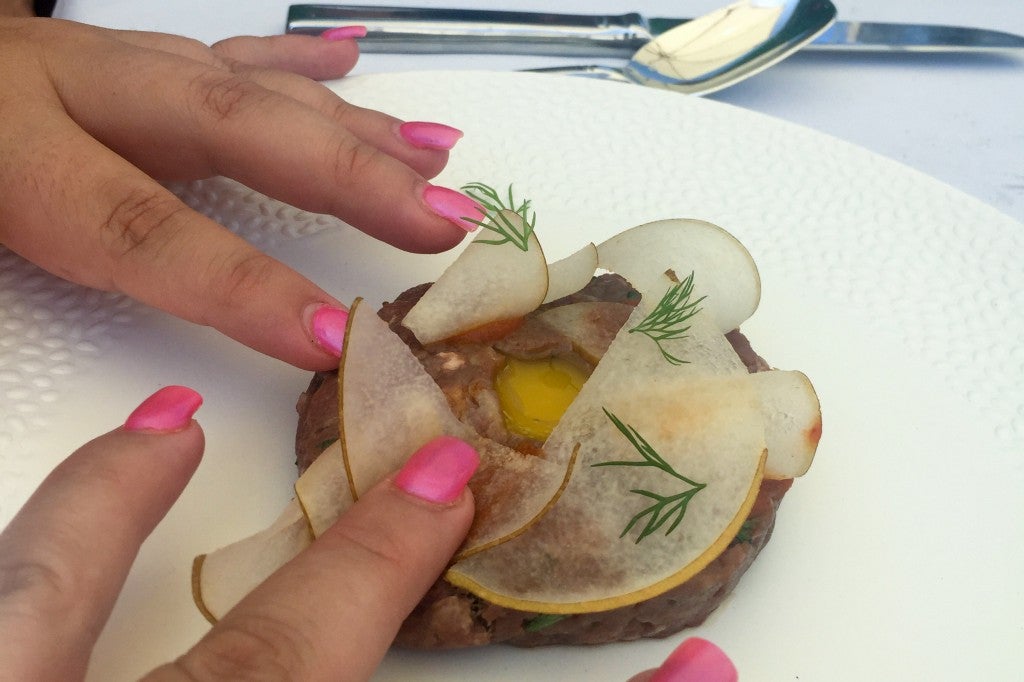
Listed on the menu as “steak and eggs,” the arrival of raw egg yolk nestled amongst large piles of raw beef shock the Herb crowd. Examining our plates as the sun beats down on us relentlessly, everyone begins looking at the other tables as if to say, “Fuck this shit.” Between the sweltering conditions and the massive amounts of weed I’m consuming at an unprecedented pace (even for me), the raw proteins couldn’t have been more unappealing.
The rest of the food, however, is tasty, especially the French toast with berry filling, maple ice cream and THC-infused syrup. In typical stoner fashion, it takes us about an hour too long to reach this closing course, though admittedly there are big breaks in-between courses, one of which includes a “low alcohol content” trio of Bloody Marys. When asked by two weed users who don’t drink for non-alcoholic versions of the heirloom juices, our waiter keeps repeating that they’re “very low alcohol,” which feels like a weird way to persuade these people to drink.
More to the point, it seems like a total talking point, prepared by the event organizers in advance to address a big debate when it comes to cannabis events like this: Is it okay to serve booze? Most veterans will say no; most young entrepreneurs, newer to the space but often richer from it, will say yeah. Either way, the whole emphasis on the “low” part of it is mostly just confusing. Are we talking kombucha-level-low or what?

All in all, our meal supposedly contains 10 milligrams of THC, a solid amount for a novice but pretty moderate for anyone else. That said, given all of the extra smoking going on, I’m relieved when I successfully stand up from my chair a couple of hours later. The other brunch guests and I are then invited to a small “island,” accessible via a concrete bridge. Upon crossing it, I receive ice-cold Eucalyptus towels, shots of fresh melon juice and ginger candies.
At the Apothecanna booth, Niko and I lay down for massages, my sunburnt shoulders soak up the THC-infused body creams, scented with peppermint and mixed with arnica to provide all-natural relief for body tension. During my massage, I overhear a woman inquiring about bringing Apothecanna’s medicated sprays and creams to places where cannabis isn’t usually permitted. The sales guy insinuates it would probably be chill, but then the woman cuts to the chase: She’s a high school teacher, and sometimes the school brings out drug dogs to sniff out the students’ stashes. She doesn’t want to guide her students out the door during a search only to be the one found out for medicating.
Next, Niko and I duck into Ashley Manta’s sex and cannabis lounge, where Manta, who has trademarked the term Cannasexual to describe the way she combines her approach to sex therapy with her passion for smoking cannabis, was offering sex advice. She gives me a sample of Foria, a weed-infused lubricant I discovered a couple years ago, and a few products from a line called Smart Mouth that really excite me. Specifically, she gives me a special mouthwash as well as a tin of moisturizing mints that apparently ensure no amount of cannabis-related-dry-mouth will ever prevent me from giving juicy head.
Before leaving the island, everyone receives gift bags full of edibles, lotions and a luxury CBD vaporizer. But the star giveaway is the Acme 420 Magar, an artisan marijuana cigar packed with close to an eighth of weed and hand-rolled in a palm-like leaf. It’s sold as a “marijuana delicacy.”
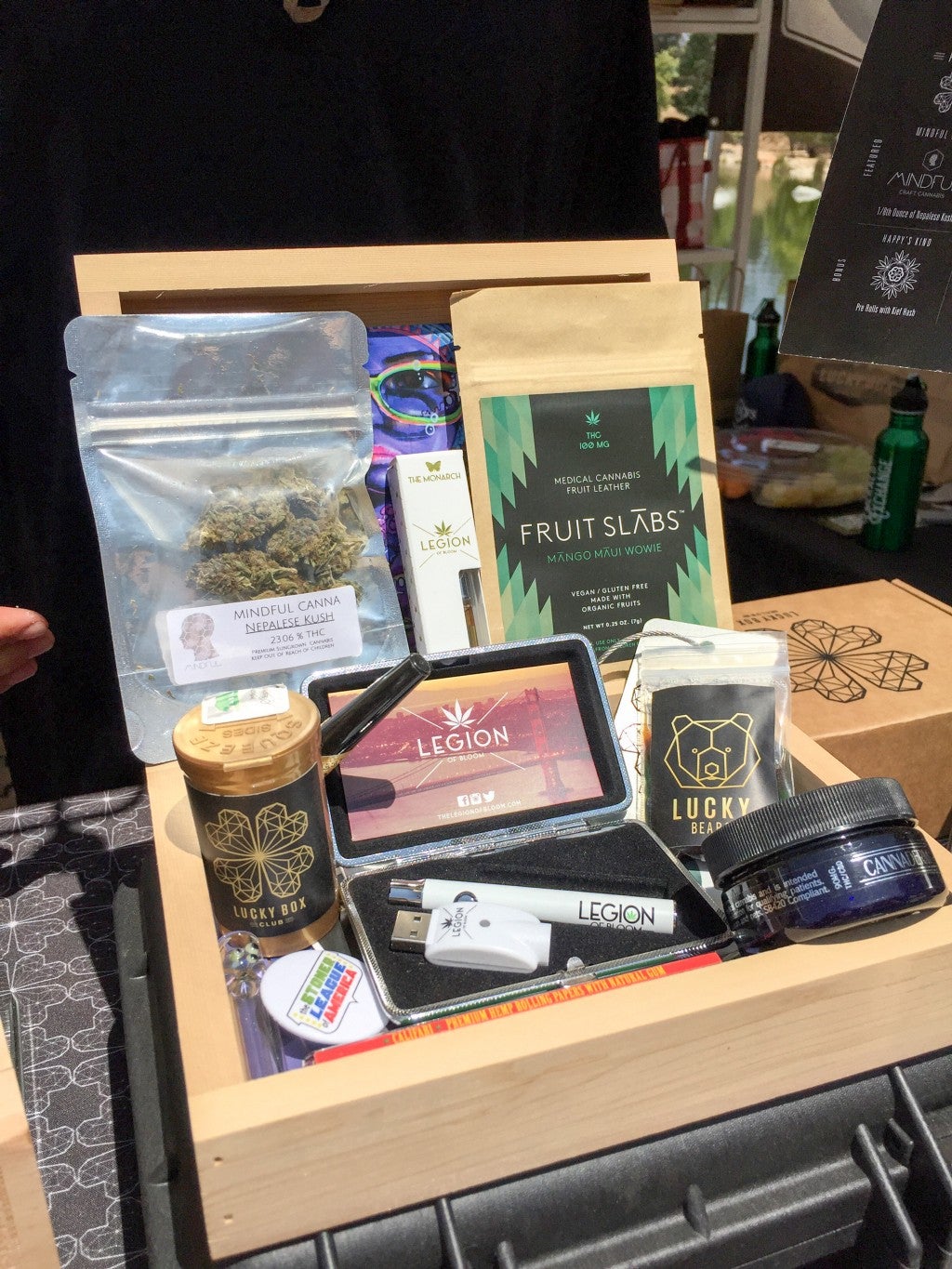
These gifts get me going, and I end my experience ravenous for more, introducing myself to the people at each and every booth in hopes of getting handed a free gram of weed or pre-roll. While I await a gift from one classic grower, a guy who looks like one of my dad’s Joe-Dirt-esque friends who my mom would roll her eyes at but would score free weed from, I overhear his drama. Peeking out from above his Oakley sunglasses, he’s convinced the red-faced guy I watched him talk to before me is a cop. From what I can make out, the guy kept asking questions that suggested the grower’s business was way less legitimate than it is. “Yes, I pay taxes,” I keep hearing the grower say. I like the drama, but I really just want my joint.
The number of booths is overwhelming. There are subscription boxes, cannabis-centric travel agencies and weed-laced-lattes. There’s weed marketed at women; weed marketed at men; and weed marketed at “bosses.” And there are packages of pre-rolls vying to replace Marlboro Reds as well as hash concentrates sold in cosmetic cases to “medicated Barbies.”
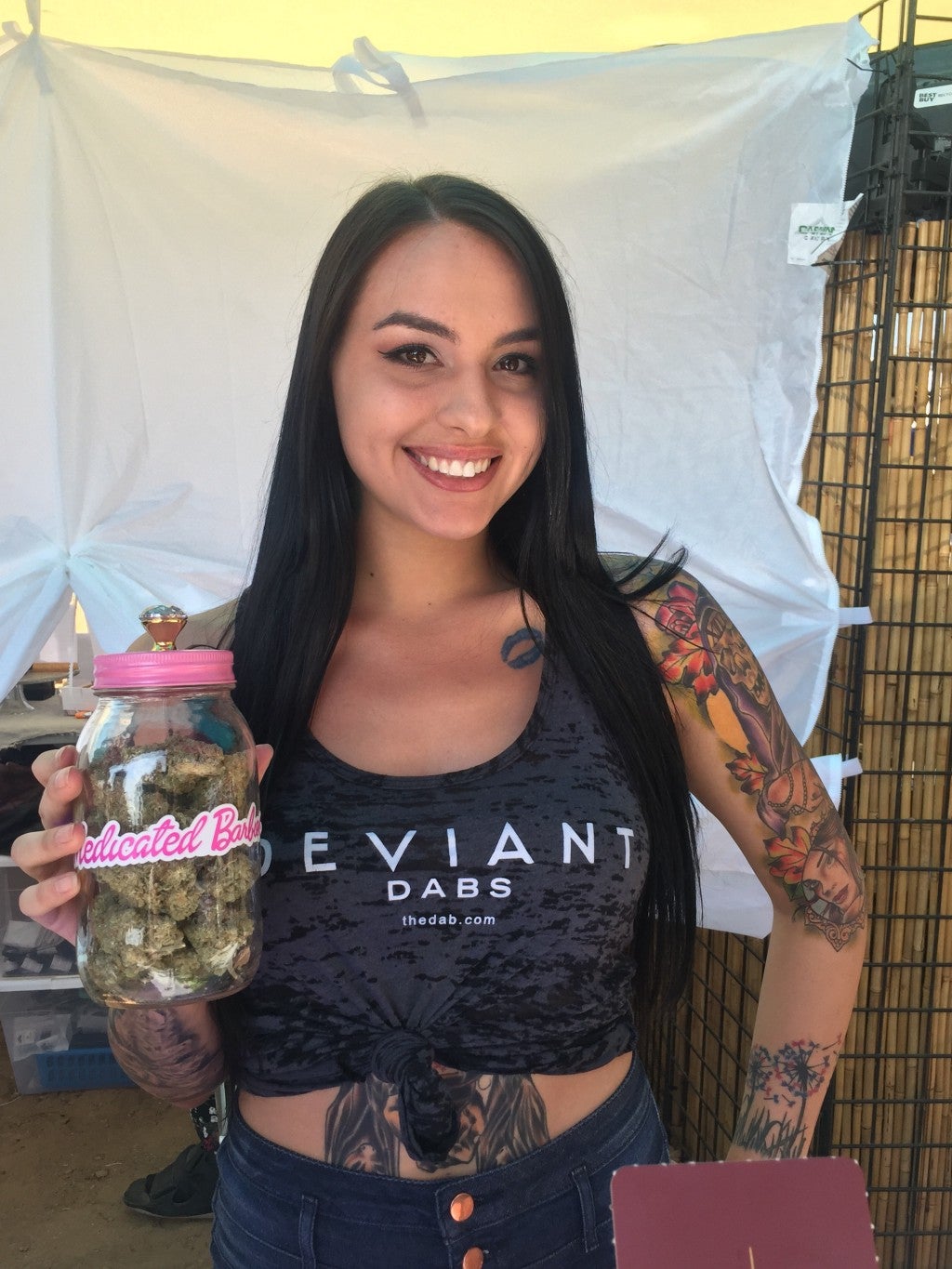
At the end of the day, after the bus ride back to the Hilton and a quick stop in the lobby to take modeling portraits of Niko, I hop into an Uber and hope I won’t get robbed. After all, I have about 15 joints and 10 edibles on me, let alone all the grams of flower these guys “donated” to me. The safe space of the Emerald Exchange had already floated away. I begin to miss it immediately. It was like trick-or-treating, except with kush instead of candy. And even if it wasn’t in Malibu, the vibe was still right. It wasn’t any big political event, it was simply a celebration of a new industry, one that’s been stigmatized as dirty drug dealing for the past century and is now nicely positioned in the wellness and lifestyle markets.
Or as my new friend Julie, who has since invited me to sesh with her in Topanga puts it, “The Emerald Exchange is a highly original experience.”
